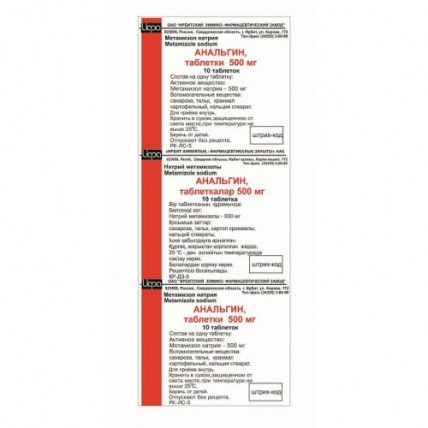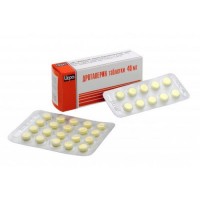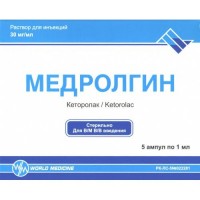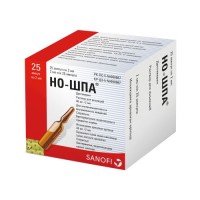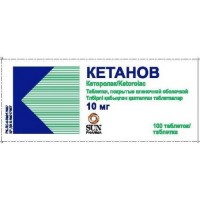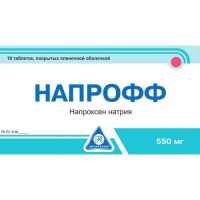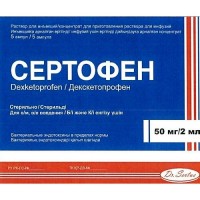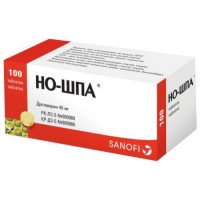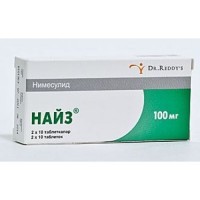Analgin (Metamizole Sodium) 500 mg, 10 tablets
- $2.00
Composition
One tablet contains:
active substance - metamizole sodium 500 mg,
auxiliary substances: potato starch, talc, refined sugar, calcium stearate.
Pharmacological properties
Pharmacokinetics
After oral administration, it is rapidly absorbed. Unchanged analgin does not enter the systemic circulation, because in the intestinal wall, it completely undergoes hydrolysis to form the active metabolite of 4-methylaminoantipyrine (4-MAA), which enters the liver with the blood stream, where it is demethylated to the second active metabolite, 4-aminoantipyrine (4-AA), and is also biotransformed to inactive metabolites - 4-formylaminoantipyrine (4-FAA) and 4-acetylaminoantipyrine (4-AcAA). In the blood, it binds reversibly to plasma proteins (4-MAA by 58%, 4-AA by 48%). The effective concentration of the sum of analgin metabolites is 10 μg / ml and is achieved 20-40 minutes after ingestion, the maximum concentration is reached 2 hours after ingestion. The toxic effect is manifested when the concentration of metabolites is over 20 μg / ml. With repeated use of the drug, its pharmacokinetics does not change. Cumulation of the drug is not observed.
The total systemic clearance of active metabolites 4-MAA and 4-AA is 182.915.1 ml / min and 55.2 ± 6.4 ml / min, respectively. Their half-life (T½) is 2.5-3.0 hours and 6-8 hours, respectively. It is excreted in the form of metabolites in the urine.
In patients with impaired renal function, if the recommended dosage regimen is observed, the accumulation of the unchanged active substance is not observed.
Pharmacodynamics
Analgin has a pronounced analgesic, antipyretic and mild anti-inflammatory effect.
The mechanism of action is associated with inhibition of the activity of cyclooxygenase I and II types. As a result, the reactions of the arachidonic cascade of eicosanoid synthesis are blocked and the formation of prostaglandins PgE2, PgF2, their endoperoxides, and bradykinin is disrupted. In the nuclei of the antinociceptive system, analgin enhances the release of kynurenic acid, which inhibits the conduction of pain impulses (due to the effect on NMDA receptors).
Interferes with the conduction of pain impulses from extra- and proprioceptive receptors along the Gaulle and Burdakh beams, increases the excitability threshold of pain centers in the thalamus. At the same time, it enhances heat transfer, reduces the activity of the thermoinstallation center of the hypothalamus.
Indications for use
- pain syndrome of weak and moderate intensity (including headache, toothache, pain in osteoarthritis, arthritis)
- diseases of the spine, accompanied by pain syndrome: lumbago, sciatica, osteochondrosis
- neuralgia, myalgia
- pain in case of injuries, burns, shingles
- febrile syndrome with acute infectious and inflammatory, insect bites (mosquitoes, mosquitoes, bees, gadflies)
Method of administration and dosage
Administered orally after meals.
Adults and children over 14 years of age are prescribed 250-500 mg (½-1 tablet) 2-3 times a day.
The maximum single dose is 1000 mg (2 tablets).
The maximum daily dose is 3000 mg (6 tablets).
Children aged 8-14 years are prescribed in a single dose - 250 mg with a frequency of administration 2-3 times a day for no more than 3 days.
Analgin in this dosage form is not recommended for children under 8 years old.
For children and adolescents from 8 to 18 years old, use only as directed by a doctor.
Side effects
- agranulocytosis, leukopenia, thrombocytopenia
- hypotension not associated with hypersensitivity reactions
- oligo- or anuria, proteinuria, interstitial nephritis
- skin allergic reactions, urticaria, exudative erythema multiforme (Stevens-Johnson syndrome), toxic epidermal necrolysis (Lyell's syndrome), Quincke's edema
- anaphylactic / anaphylactoid reactions, bronchospasm
- nausea, vomiting, anarexia, epigastric pain, flatulence, constipation
- paresthesias, tinnitus, visual impairment, tremors, depression
Contraindications
- hypersensitivity to analgin and other pyrazolone derivatives (propiphenazone, phenylbutazone, phenazone-containing agents)
- acute hepatic porphyria
- deficiency of glucose-6-phosphate dehydrogenase
- oppression of hematopoiesis (agranulocytosis, cytotoxic or infectious neutropenia)
- severe impairment of liver and / or kidney function
- anamnestic data on attacks of bronchial asthma, urticaria, acute rhinitis associated with the use of non-steroidal anti-inflammatory drugs, other drugs that suppress the production of prostaglandins
- a history of gastric ulcer and duodenal ulcer
- pregnancy and the period of breastfeeding
Drug interactions
With simultaneous use with other analgesics-antipyretics and non-steroidal anti-inflammatory drugs, mutual intensification of toxic effects is possible.
The action of analgin is enhanced when used together with barbiturates, codeine, H2-blockers of histamine receptors, anaprilin (due to the slowdown in inactivation of the drug).
Increases the risk of developing leukopenia when used together with thiamazole and cytostatic agents.
Analgin displaces oral sugar reduction aids from binding to protein and thereby increasing their effect.
It enhances the activity of indirect anticoagulants, glucocorticosteroids and indomethacin due to their displacement from the connection with blood proteins.
Analgin enhances the sedative effect of ethyl alcohol.
Analgin lowers the concentration of cyclosporin A in the blood plasma.
With simultaneous use with phenothiazine derivatives, the development of severe hyperthermia is possible.
Tricyclic antidepressants, combined oral contraceptives and allopurinol slow down the metabolism of analgin and increase its toxicity.
With simultaneous use with myotropic antispasmodics (drotaverine, papaverine, pitofenone) and m-anticholinergics (fenpiverinium bromide, platifillin, atropine), there is a mutual increase in the analgesic, antispasmodic and antipyretic activity of this combination.
Caffeine enhances the effect of the drug.
Special instructions
Long-term use of analgin
If it is necessary to regularly use analgin for more than 5 days, the peripheral blood picture should be monitored weekly.
Acute abdominal pain
The use of analgin is not recommended for the relief of acute abdominal pain until its cause is clarified.
Use in persons with pathology of the cardiovascular system
Careful monitoring of hemodynamics is required, especially in patients with a systolic pressure below 100 mm Hg, a history of kidney disease (pyelonephritis and glomerulonephritis), as well as in persons with alcohol dependence.
Excretion of analgin biotransformation products in the urine can cause red coloration of urine, which has no clinical significance and disappears after discontinuation of the drug.
Agranulocytosis
In the event of an unexpected deterioration in the general condition of the patient during treatment with analgin, manifested by an increase in temperature, inflammation of the mucous membranes of the oral cavity and pharynx (necrotizing stomatitis, purulent-necrotic tonsillitis), nose (sinusitis), increased ESR, taking analgin should be stopped immediately, because... these symptoms may be associated with the development of agranulocytosis.
Use in pediatrics
It is not recommended to use analgin in children under 8 years of age in this dosage form and due to the increased risk of developing renal dysfunction.
Features of the influence of the drug on the ability to drive vehicles and control potentially dangerous mechanisms
Reception of analgin does not affect the ability to drive vehicles or other mechanisms during the period of use of the drug, but caution should be exercised with prolonged use.
Overdose
It occurs when the level of analgin metabolites is more than 20 μg / ml in blood plasma. Symptoms: vomiting, hypothermia, hypotension, palpitations, shortness of breath, drowsiness, confusion and delirium, impaired liver and kidney function, convulsions.
Treatment: discontinuation of the drug, gastric lavage, intake of activated charcoal and the appointment of saline laxatives to prevent absorption of the drug in the stomach and intestines. Forced diuresis and alkalinization of urine by introducing sodium bicarbonate accelerate the excretion of analgin. Supportive and symptomatic therapy is carried out, aimed at eliminating the violations that have arisen. There is no specific antidote.
Storage conditions
Store in a dry, dark place at a temperature not exceeding 25 ºС.
Keep out of the reach of children!
Shelf life - 5 years
Do not use after the expiration date.
